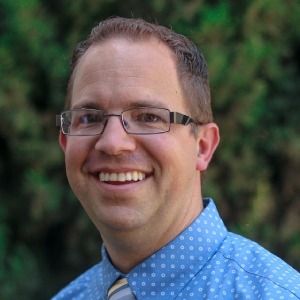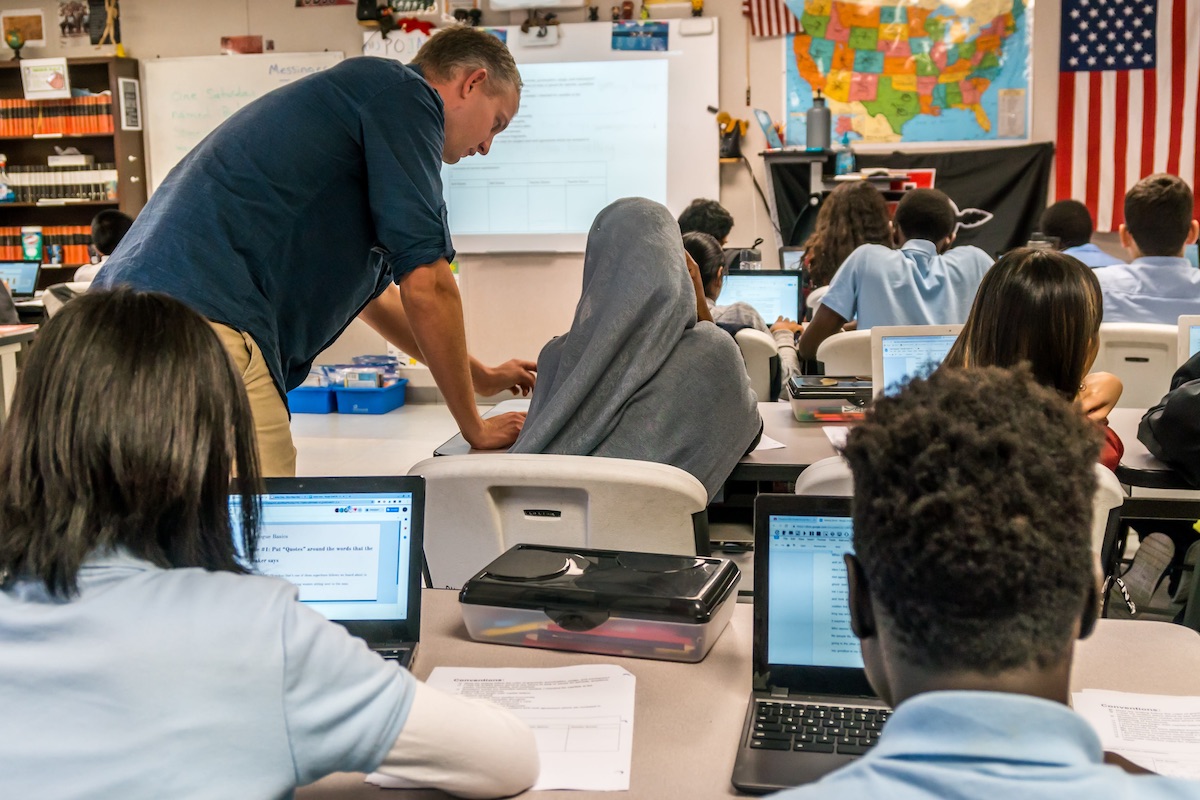Self-Care and Support: The Pillars of New Teacher Survival

Dear New Teacher,
We see you walking across the campus as the sun rises with your Starbucks in one hand and your carefully crafted lessons in the other. We see you at lunch, students streaming in and out of your class as you provide a safe place for the misfits, the band geeks, the jocks and all of the students in between. We see your lone car in the parking lot on a Saturday as you prep materials for the week ahead.
Know that your efforts are not in vain and they do not go unnoticed. Working with you is refreshing. You’ve yet to acquire the caustic wit that, at times, echoes in a Teacher’s Lounge, but rather you are consumed with a passion to make a difference. Today, please be reminded that you are needed. We hope to see you trotting across campus with your Starbucks for many years to come. So, we invite you to have a seat, prop your feet up and lend an ear to what we hope you will read as advice offered in love and with great hope for your career.
Pillar One: The Art of Self-Care
We have all heard the familiar directive, “You can’t pour from an empty cup. Take care of yourself first.” My colleague, Michael Uretsky, brought this concept home in a class of student teachers. He recounted the process of being on a plane and listening to the directions of the stewardess. Without fail, travelers are directed, in the event of the loss of cabin pressure, to first place the oxygen mask on themselves. As a mother, this was always a hard message to hear. My instinct was and is always first for my children. And, so it is, for us as educators.

Our work is never done. There will always be another stack of papers to grade, another parent to call, a new lesson to create or a committee to serve on. However, without learning the art of self-care, we will be unable to effectively care for those we most want to impact.
The impact of teacher burnout is staggering. Within three years of working in the profession, approximately thirty percent of new teachers leave and by the five-year mark that percentage rises to nearly fifty percent (Stansbury and Zimmerman, 2002; Hammerness and Matsko, 2012). Urban schools report even more alarming attrition rates as high as seventy percent at the five-year mark (Hammerness and Matsko, 2010). This extreme turnover rate is devastating to the landscape of education. Schools invest substantial funds in replacing these teachers, but most importantly students are unable to benefit from the expertise of veteran educators who remain in the profession, allowing their craft of teaching to mature and evolve (Dean, 2016).
For these reasons, the topic of self-care must be discussed with new teachers in order to retain qualified educators in the profession for a sustained career. Efforts to do so will result in benefits for not only teachers, but students and school sites as well.
Putting Self-Care into Practice
So, where do we start? Let me suggest some ways that all educators can utilize to take steps towards creating a healthier balance of self-care.
1. Use your calendar to support self-care.
With the busy schedules we all maintain today, what is important for us needs to be scheduled. Calendar in time to have coffee with a friend, to go on a date with your spouse and to exercise. Then, stick with it!
2. Honor bedtime.
“Sleep is one of the most overlooked restorative activities we can do. There is no “magic number” of hours a person must sleep based on age, but most adults need to sleep 7–9 hours nightly” (Dean, Chapter 5, page 2).
3. Maintain the priority of your health.
With long to do lists, it is easy to overlook the basics. Eating right and exercising regularly help to sustain our health, stabilize our moods, and keep us balanced. Allow time to care for your physical needs.

4. Create routines that allow you to engage with your “people”
You need scheduled times to meet up with people that understand the unique pressures of being an educator. Your spouse and best friend, while essential to your happiness, may not relate to the demands of your teaching job. Create a routine that allows you to engage with those that do! I benefited from regular dinners out with my friends and colleagues. We met on the first Friday of every month for dinner. This was a scheduled time that I could count on for my own personal enjoyment and for support from those that understood the demands of my job.
5. Allow time for hobbies and activities that bring you joy.
Winston Churchill wrote, “To be really happy and really safe, one ought to have at least two or three hobbies, and they must all be real” (Winston Churchill Biography, 2019). Science proves that our productivity and happiness increase with participation in hobbies. According to Rosen, “Research has linked participation in leisure activities to many measures of physical and mental well-being, from reduced blood pressure to a sense of belonging (2018).
6. Put limits on unproductive work time.
As part of your self-care plan, work in ways that are productive. Often when we are tired and overwhelmed, we invest hours in tasks that can be completed in a much shorter period of time. Have you ever found yourself staring at the blinking cursor on your computer? If so, it is time to take a break. Many find success utilizing the Pomodoro Technique. Essentially, this technique is a time management tool. There are six steps in the original technique:
- Decide on the task to be done.
- Set the Pomodoro timer (traditionally to 25 minutes).
- Work on the task until the timer goes off. (If something unrelated to the task comes up, you can jot it down, but deal with it later.)
- End work when the timer rings and put a checkmark on a piece of paper.
- If you have fewer than four checkmarks, take a short break (3–5 minutes), then go to step 2.
- After four Pomodoros, take a longer break (15–30 minutes), reset your checkmark count to zero, then go to step 1.
Ultimately, the practices you chose for self-care are irrelevant; however, it is essential that you create space and time for these practices. Remind yourself that in order to serve others, you must first serve yourself. So, go ahead and strap on that oxygen mask and make a plan how to best meet your own needs in order to serve your students impactfully.
Pillar Two: Effective Systems of Support
When I was finishing my teacher preparation program, one of my professors asked my peers and me what we feared as we transitioned to licensed teachers. My peers replies reflected traditional fears of a soon-to-be, first-year teacher such as managing a classroom or having sufficient content knowledge. In contrast, my greatest fear was how I would continue my professional growth. During my student teaching, I was fortunate to serve as an intern filling a vacancy as a secondary English teacher for the local school district trying to curb a teacher shortage. Taking coursework while simultaneously serving as an intern narrowed the theory to practice bridge for me, and it afforded me daily opportunities to apply the content I learned in my university coursework to my work as an intern. I felt I was becoming a better teacher. Now, I worried if my professional learning would stop as a result of not going to school.
While my student teaching experience was unconventional in the era I was trained, it is more representative of the experiences you may have had in your teacher preparation program. The traditional model which positions coursework first followed by student teaching is becoming a thing of the past (Scherer). Current teacher preparation programs connect coursework simultaneously with field experience. As a result, the teacher candidates I now supervise as a teacher educator are having more opportunities to connect coursework to practice. Consequently, they are asking the same question I asked and you may also be asking as you are preparing to begin your first year—how will I continue to grow as a teacher? I believe an answer is ensuring as a new teacher you have (1) support from a mentor and (2) access to professional learning opportunities.
Support from a Mentor
Research has indicated new teachers were more committed to their jobs, possessed higher job satisfaction, showed positive gains in student achievement, and more likely to be retained in the profession when they participated in mentoring (Ingersoll and Strong, 2012). However, finding a mentor as the new kid on the block may be challenging. Here are some tips to connect with a mentor.
Seek out a mentor with whom you connect naturally. Often the trend in many districts is that you will be assigned a mentor. For example, in my first year of teaching I had a retired teacher who would come visit me monthly to check in to provide me support. While I appreciated this man and his service, I found the greatest mentoring I received was from my grade-level colleague and department chair down the hall. We spent many hours before and after school, in conversations during passing period, our shared prep period, and lunch discussing topics related to my role as a teacher in that specific school. The mentoring relationship was not assigned but rather emerged from a variety of variables, of which most importantly was our proximity to each other. I recommend you allow a mentor to emerge from your interactions with your new colleagues as you are collectively engaging in your work to educate students (Long).
However, if this does not happen naturally and you begin to feel isolated, do not be afraid to seek out advice from your colleagues within your grade level and/or department or in other departments within your school. Do not let your fear of others’ judgements stop you from reaching out. Just remember–we all once stood where you now stand. You will find most veteran teachers are more than willing to provide support.
Select a mentor who has the time, desire, and capacity to coach you. You may also need a mentor who can provide more support for you than just out-of-classroom chats. For example, if you are struggling with classroom management, it might be necessary for your mentor to observe you in your classroom, to possibly model effective practices, and/or to go observe other teachers together. My first year of teaching while observing a colleague in my department, I noticed she had a way of productively getting her students to work. I asked how she was able to do that and she explained. The problem was that I thought I was doing that, but I still had unruly and off-task student behavior. She volunteered to come watch my class during her prep. She then was able to notice and provide feedback on small in-the-moment moves I could make to better improve student behavior. This coaching and mentoring was incredibly helpful, but it was only possible because my colleague had the time, desire, and capacity to help me. Therefore, make sure your mentor can commit to you. However, if scheduling is an issue, record yourself and review it with your mentor later (Blomberg, Renkl, Gamoran Sherin, Borko, & Seidel, 2013).

Additionally, you need to be aware of the mentoring you need. You may need a mentor to provide instructional mentoring (e.g., classroom management support, curriculum and instruction development, etc.). This is someone who likely should come from your grade level team. Likewise, you may need someone to provide what I term site-specific support such as setting up the gradebook, requesting a substitute, locating resources are on campus, and other tasks not directly related to pedagogy but associated with the culture of the site where you are placed. This can come from anyone who is available and to whom you can gain access. I would suggest asking your supervisor or your grade level leader, who can help you with those things. Otherwise, my invitation is to join a lunch group or take a walk to a colleague’s classroom for a discussion regarding these inquiries. Also, do not forget to make friends with the school staff. Sometimes the best kept secrets in a school comes from the graphics room or the front desk secretary.
Access to Professional Learning Opportunities
I was encouraged early in my first year to explore an additional avenue for professional growth, professional development opportunities. Those come in a variety of ways. For example, I spent my first year joining an organization that offered me a plethora of professional literature that afforded me various opportunities to grow. The organizations can you help you develop both your general teaching practice as well as your subject-specific pedagogy. If money is an issue, see if your administration offers a professional learning stipend or if they would be willing to fund you in joining a professional organization.
Additionally, before I began my first teaching assignment, my principal personally invited me to attend a regional conference that summer where I gleaned ideas that are still influential to my practice today. Unfortunately, many new teachers are not aware that these learning opportunities exist, so reach out and ask. Principals love teachers who take charge of their professional learning. There are always local opportunities at your site and within the district such as workshops, instructional coaching, peer observations, and book studies. My recommendation would be to reflect on your practice, set a professional learning goal, and then seek out the best resources to help you meet that goal. I found going through this process has made me a better teacher and gave me renewed excitement each day as I endeavored to teach my students and help them succeed.
Take heart and apply a few of these ideas! See if they don’t make a difference in your overall well-being! Applying these ideas and seeking additional ways to take care of yourself and to seek professional growth will lay the foundation for your ability to make a difference in students’ lives for years to come.
Sincerely,
Derek and Heather
This article is available and can be accessed in Spanish here.
Blomberg, G., Renkl, A., Gamoran Sherin, M., Borko, H., & Seidel, T. (2013). Five research-based heuristics for using video in pre-service teacher education. Journal for Educational Research Online, 5(1), 90-114. Retrieved from https://www.pedocs.de/volltexte/2013/8021/pdf/JERO_2013_1_Blomberg_et_al_Five_research_based_heuristics.pdf
Callahan, J. (2016). Encouraging retention of new teachers through mentoring strategies. Delta Kappa Gamma Bulletin, 83(1), 6. Retrieved from http://www.deltakappagamma.org/GA-betaepsilon/Newsletters/2016_Jour_83-1_Early-Career-Educators_web.pdf#page=6
Dean, H. (2016). Exploring novice teachers’ perceptions of the impact of an induction program: A qualitative case study (Unpublished doctoral dissertation). Thesis / Dissertation ETD.
Dean, H. (2018). Thrive, not survive: A guide for first year teachers. Dubuque, IN: Kendall Hunt Publishing Company.
Hammerness, K., & Matsko, K. K. (2013). When context has content: A case study of new teacher induction in the university of Chicago’s urban teacher education program. Urban Education, 48(4), 557-584.
Ingersoll, R., & Strong, M. (2012). What the Research Tells Us about the Impact of Induction and Mentoring Programs for Beginning Teachers. Yearbook of the National Society for the Study of Education, 111(2), 466-490.
Long, J. (2010). The fatal attraction of mentoring: Mentoring for retention of beginning teachers.
The International Journal of Interdisciplinary Social Sciences, 5(2), 265-274.
Rosen, J. (2018, June 18). How a hobby can boost researchers’ productivity and creativity. Retrieved March 20, 2019, from https://www.nature.com/articles/d41586-018-05449-7
Scherer, M. (2012). The challenges of supporting new teachers. Educational Leadership, 69(8), 18-23.
Stansbury, K., & Zimmerman, J. (2002). Smart induction programs become lifelines for the beginning teacher. Journal of Staff Development, 23(4), 10-17.
Winston Churchill Biography. (2019). Retrieved March 20, 2019, from https://www.nationalchurchillmuseum.org/winston-churchill-biography.html










